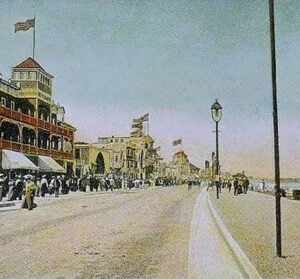We frequently encounter “lodgers” or “boarders” living with our ancestral relations in 20-century U.S. census records. If you’re like me, you probably don’t pay much attention to them. However, as I recently discovered twice while researching the lives and descendants of Irish immigrant Bostonians Edward J. Costello (1866-1926 [?]) and Mary Josephine Maloney (c. 1872-1943), these oft-disregarded “lodgers” or “boarders” can turn out to be your relatives after all. Both cases led to interesting discoveries, but recounting them together would far exceed the average length for posts on this site—so I offer them in two parts.
Our first case of a misidentified relative, 11-year old “lodger” George Stepper, was encountered in the January 1920 census enumeration of the household of Joshua and Mary Harron at 149 Bellingham Ave, in the coastal Beachmont neighborhood of Revere, Massachusetts.
Where do the Harrons and their young “lodger” belong in the context of my research into the Costellos? Edward Costello and Mary Maloney married in 1891 and had nine children, but only six survived childhood. On 16 October 1912, their 18-year old first child Mary J. Costello (1893-1963) married 22-year old Guido De Vito (1890-1950), immigrant son of Vincenzo De Vito (1865-1941) and Philomena Viola (c. 1864-1939). Mary and Guido had five children: Francis, Joseph, Anne, Arthur, and Paul. Their middle child, Anne Marie “Annie” De Vito (1917-1990) married Elbert Joshua/Joseph Harron (1904-1981), son of Boston-born Joshua A. Harron (1872-1953) and Irish immigrant Mary A. Craven (1874-1959), in Beachmont on August 6, 1945.
My curiosity about the Harron and Craven families uncovered a succession of sad stories that will explain how “boarder” George Stepper came to live with the Harrons. Joshua Harron had considerable business acumen, but it got him and his family into serious trouble. Moreover, he and Mary experienced the tragic loss of three of their children. The Harrons had six children during 1897-1906: Mildred, Frances, Thelma, twins Elbert and Madeline, and Reginald. Madeline died of bronchopneumonia on 28 November 1904, aged 3 months and 24 days. About eight years later, on 24 January 1913, 12-year old Thelma died. Meanwhile, Joshua’s business and public profile prospered, and in December 1916 he opened and became president of Revere Trust Co.
In October 1929, the Harrons lost a third daughter, 32-year old Mildred, a music teacher at Revere High School, after an illness of several months. Eighteen months later, in October 1931, their lives and livelihoods were upended when the State Bank Commissioner closed Revere Trust Co. following a run on its cash reserves. Joshua and other prominent business and political figures were held liable for the liquidation of shares for $5 million in bad loans and investments. The Master’s 1935 report on bank closures alleged that Harron acted in “bad faith and deliberate and intentional breach of trust.” Unemployed and under investigation, Joshua took a job as assistant manager of a Revere ballroom dance hall, earning only $15-20 per week. He owed more than $1,500 for family medical expenses, had no assets or bank account, and didn’t pay taxes for the years 1932 and 1933.
Sometime after April 1935, the Harrons moved to unincorporated Hyannis, one of seven villages in the town of Barnstable, Barnstable Co. The April 1940 census shows their 31-year old unmarried nephew George Stepper still living with them. In the April 1950 census, 42-year old George was married, a salesman for a batting company, and living in Lynn, Essex Co., MA, with his Massachusetts-born wife Miriam F. [Kelley] (37) and their 5-year old daughter Susan F.
So who was George Francis Stepper, who lived with Joshua and Mary Harron for more than 20 years, from before 1920 to the early 1940s? Further research revealed that George was the son of Frank I. Stepper and Delia J. Craven, the sister of Joshua’s wife Mary. I also discovered that the Steppers, Cravens, and Harrons had experienced a plague of premature deaths.
Delia was born in Boston on 7 February 1882 to Irish immigrants John Craven and Catherine Francis. She married Boston native Francis Ignatius “Frank” Stepper on 20 August 1902 and had two children, Rose Frances (b. 30 July 1903) and George Francis (b. 24 February 1908). In mid-1909 Frank contracted pulmonary tuberculosis and died several months later, on 23 February 1910, at age 30. Seven years later, on 12 May 1917, Delia also succumbed to pulmonary tuberculosis that she contracted a year earlier.
After Delia’s death, her two young orphaned children went to live with relatives. Rose, who was 13 when her mother died, lived with her paternal grandparents Edward and Mary (Hennessey) Stepper. In the January 1920 census she was 16 and residing with them in Dorchester, Boston. She had graduated from William E. Russell Elementary School and was attending high school.
Rose’s brother George Stepper, who was 9 when his mother Delia died, went to live with his maternal aunt Mary Harron’s family, and remained with them until the early 1940s when he married and moved to Lynn—several miles northeast of downtown Boston, just beyond Revere.
This sad family story does not end here. Catherine Craven, mother of Delia Stepper and Mary Harron, died on 14 June 1918, a year after Delia’s death. Mary Stepper died on 13 November 1922, followed by her husband Edward in 1924, leaving their granddaughter Rose on her own. Four years later, Rose herself died just short of her 25th birthday. Finally, on 12 August 1933, John Craven, age 75, husband of the late Catherine Craven and father of Delia Stepper and Mary Harron, died. He had been living with Mary and Joshua at 177 Bellingham Ave., Beachmont.
George Francis Stepper too had a short life. During the 1930s and forties he worked as a salesman for various automobile dealerships. In 1941 he married Miriam Frances Kelley, born on 10 November 1912 to Frederick Clifford Kelley (1893-1937) and Irene Nora Girard (1894-1968). In the April 1950 census George F. (42), wife Miriam F. (37), and their daughter Susan F.[rances] (5) were living at 15 Vine St., Apt. 16, in Lynn, where George was a salesman for a batting company. George died in 1951, in his early forties. Miriam died fifty years later, in 1991, in her late seventies.
As for George’s aunt and uncle, with whom he lived for more than two decades after his parents died in the 1910s: Joshua Harron died in 1953 in Florida, and his wife Mary (Craven) Harron died in Hyannis in 1959. Quite a story that might have been overlooked had not 11-year old “lodger” George Stepper captured my attention!
Share this:

About Joe Smaldone
Joe Smaldone and his wife Judy Warwick Smaldone have been researching their family’s history for more than 20 years. Their research has taken them to many national, state, and local libraries, archives, court houses, churches, cemeteries, historical and genealogical societies, and other research sites across the United States, and abroad to Ireland, Italy, and Sweden. They are members of NEHGS and the New York Genealogical and Biographical Society. Joe was an adjunct professor at Georgetown University, where he created and taught a course entitled Your Family in History. He is a Genealogy Research Consultant at the FamilySearch Center, Annapolis, Maryland, and has published numerous genealogical studies, articles, abstracts, blog posts, and indexes.View all posts by Joe Smaldone →

